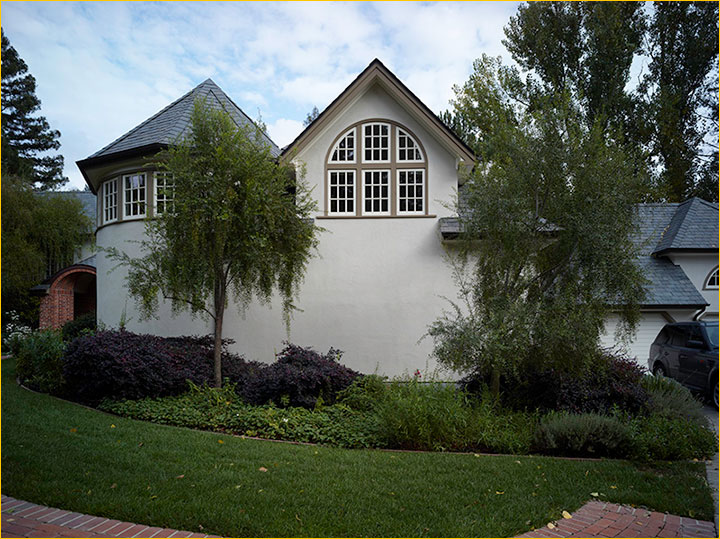NEW SOFTWARE AND A FIELD TEST OF SEVERAL NEW PRODUCTS
By Mark Dubovoy
INTRODUCTION
ALPA contacted me several weeks ago. They wanted me to beta test a new product. Given that an ALPA is my main camera for landscape work, I was very interested to find out what the new product was and I agreed to be a beta tester. It was only then that I found out they were talking about a software product. I was a little miffed. What would ALPA be doing in the software world?
To make a long story short, this led to a series of emails, and the company also sent me the latest model of their MAX camera, a brand new groundglass that is replacing the old groundglass, several other accessories and three of the newest lenses. I was able to field test this equipment during the recent PhaseOne Digital Artist Series (PODAS) workshop in Death Valley.
I should point out that I have no commercial relationship with ALPA, and I received no remuneration for performing these tests. Everything I say in this article is exactly how I see things, with no external biases or influences.
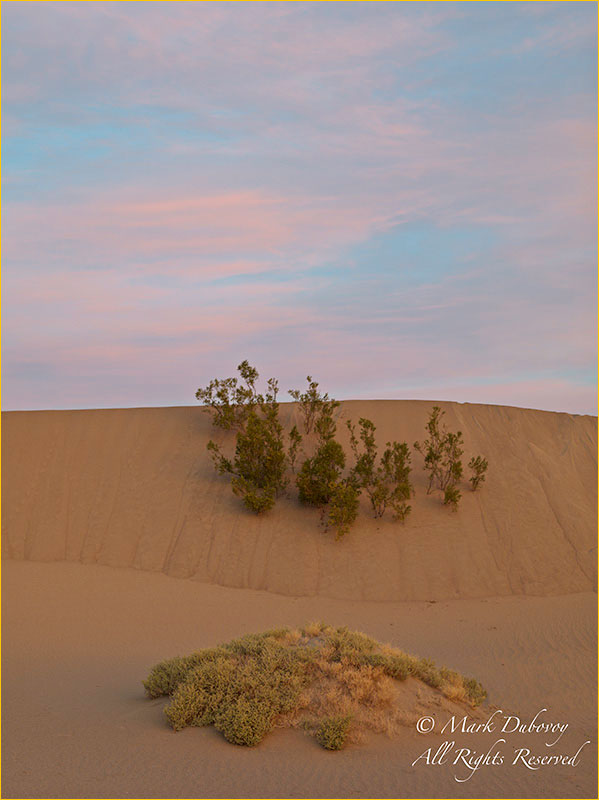
DUNES AND PLANTS AT SUNRISE
ALPA SWA with 180 mm Rodenstock APO HR lens at F/11
___________________________________________________________________________________
ALPA LENS CORRECTOR
The software product in question is the ALPA Lens Corrector. The product should be available in its final version by the time you read this. Come to think of it, it makes all the sense in the world for ALPA to develop a software product that corrects lens aberrations such as barrel distortion, pincushion distortion and other kinds of distortion. After all, many of their customers are architectural and interior photographers, and many of their cameras are also used for scientific purposes. No one else was likely to develop a lens correction product for the vast array of Schneider, ALPA and Rodenstock lenses in the ALPA line.
Nothing is done halfway at ALPA. They have a commitment to make each and every product as best as it can be. The company worked with top experts in photogrammetry and imaging at several universities (Institute of Geological Science, University of Bern; Dept. of Geomatics, CRC for Spatial Information, University of Melbourne and a software company in Stockholm) in order to develop the best lens corrector possible.
The result, as far as I can tell, is an outstanding product. I did a number of tests with different lenses shooting subjects with vertical and horizontal straight lines, and the results are outstanding. The geometry of the final images always looks correct.
The product is a plug-in for Photoshop, and it is quite easy to install and straightforward to use. Once the image is open in Photoshop, you go to File>Automate>ALPA LC. This opens the ALPA lens corrector pane.
At this point you need to enter the specific lens and digital back model that you are using. You do this by navigating to a folder that comes with the software, which has all the different combinations of backs and lenses. With some backs, even the shooting mode is critical, for example, using a P65+ the corrections are different for Sensor Plus mode versus Normal mode. If you used vertical rise/fall or lateral shift, you also enter this information in millimeters. This is necessary, because if the optical center of the lens is not in the center of the image, compensation for this discrepancy must be calculated. Then you click on the execute button and the software corrects the image.
It is all quite logical and very simple to use.
A typical visual example of what the lens corrector does is the following image, taken with an ALPA 12 SWA and the Schneider 35 mm APO Digitar XL. The first image is “as is”. The second image has lens correction applied. By comparison with the corrected image, the uncorrected image looks like it has a “bulge” in the center. The corrected image is dead-on accurate for this particular scene.
THE ABOVE FRAME IS WITHOUT LENS CORRECTION
PASS YOUR MOUSE OVER IT TO VIEW WITH LENS CORRECTION
I would like to give ALPA Kudos not only for the excellent lens correction, but also for making the software available to ALPA users for free. Simply send an email to the company requesting the software and include your camera’s serial number. The company will then reply to you with a link to the download.
___________________________________________________________________________________
A GROUNDBREAKING GROUNDGLASS?
One of the new pieces of hardware that ALPA sent me was their new groundglass. So what is so important about a groundglass? Everything! For those of us who shoot with either view cameras or technical cameras, the importance of a good groundglass cannot be overemphasized; after all, the groundglass is where we compose and focus our images.
Over the years, I have used many groundglasses from companies such as Sinar, Linhof, Cambo, Deardorf, Ebony, Wista, Maxwell, Beatty and others. I also tried a device (Boscreen) that uses a layer of paraffin instead of a groundglass.
The aim was always the same, trying to find a device that was bright, without grain (not quite possible), and a device that allowed images to clearly pop in and out of focus.
I believe the new ALPA groundglass is truly groundbreaking (pun intended). It is, in one word: extraordinary. It is practically grainless and even the smallest detail is visible and clearly pops in and out of focus. Furthermore, it has an extremely fine grid etched into the glass. The grid is so fine that it does not interfere at all when looking at the full image, yet it has enough lines in it to make it extremely useful for composing and leveling.
The picture below shows the old groundglass on the right side, the new one on the left. Although it is impossible to tell the real difference in one picture, what is extremely obvious is the difference between the usual printed lines in groundglasses, versus the extremely fine etched grid in the new groundglass.
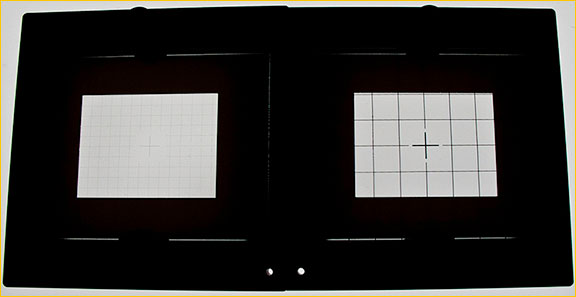
This is by quite a margin the best groundglass I have ever seen. I can assure you that if you use this groundglass once; you will not like anything else on the market.
___________________________________________________________________________________
ALPA 12 SWA AND MAX CAMERAS
The first ALPA camera I purchased was an ALPA TC. I wanted the smallest body for travel purposes.
As time went by, I decided to replace it with a 12SWA with natural rosewood grips with the PhaseOne cables and wake up button built into the grips. I believe that ALPA is the only company that offers built-in trigger cables for PhaseOne backs in the grips.
___________________________________________________________________________________
MY PERSONAL ALPA 12 SWA
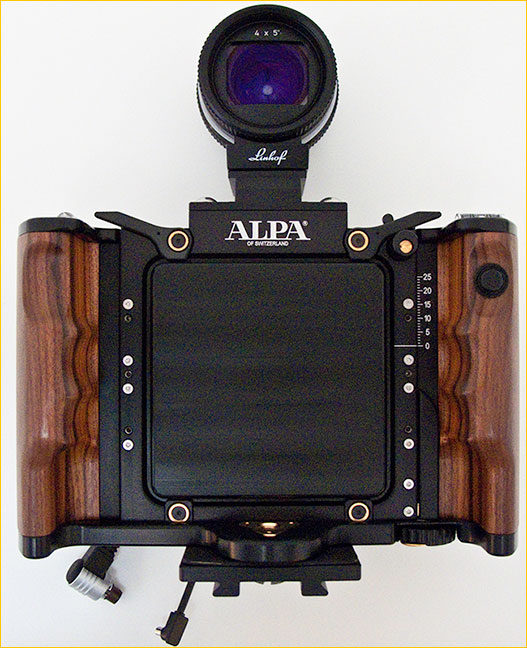
This has been my favorite camera from the day I purchased it. Note that I normally attach my old 4×5 Linhof Master Technica viewfinder to the camera. I find this viewfinder extremely useful to help me determine which lens to mount on the camera before using the groundglass. Also, the ALPA adapter for this viewfinder is accurate enough, that I can use the Linhof viewfinder for shooting without looking at the groundglass if I so please.
ALPA was kind enough to send me the larger brother, the ALPA MAX for a field test in Death Valley.
The basic difference between the two cameras is that the MAX has a larger range of movements, which makes the camera somewhat bigger and heavier, but more suitable for certain applications. It was sent to me with a set of new soft “rubbery” (even though it is not rubber) grips and an ALPA viewfinder.
You can clearly see from the picture that the MAX has more extensive front rise and fall. It also has horizontal rear shift (which the SWA does not). The MAX is particularly well suited for stitching panoramas. Move the back to the far left and shoot. Then, move it to the zero detente in the middle for your second exposure. Finally, slide the back to the right for your final exposure. Perfect, the lens did not move, only the back.
The camera is also highly suitable for architecture and interiors, and for extreme movements in landscape and other fields.
By the way, ALPA does not offer a sliding back adapter. Their reason for this is that they do not believe that a sliding back adapter can hold the necessary precision and stability after heavy use. They will not make a product that cannot withstand years of professional use.
ALPA does make a beautiful tilt adapter for lenses 80 mm and longer.
Because of the added distance to the sensor when the adapter is installed, it requires lenses to be mounted in a shorter barrel than the standard barrel. I thought long and hard as to whether I wanted to use the tilt adapter with my personal camera. In the end, I decided that the Helicon Focus software (see my prior article on this site) did everything I needed to extend depth of field. The ideal camera for me only needs front rise, which is why I ended up with the SWA as my personal camera.
For the exact specifications on all the cameras, lenses and other products, as well as for a history of the company, I suggest that you go directly to their web site http://www.alpa.ch
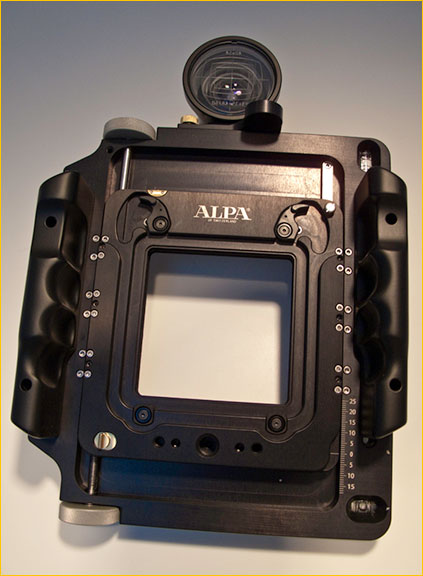
ALPA MAX VIEWED FROM THE FRONT
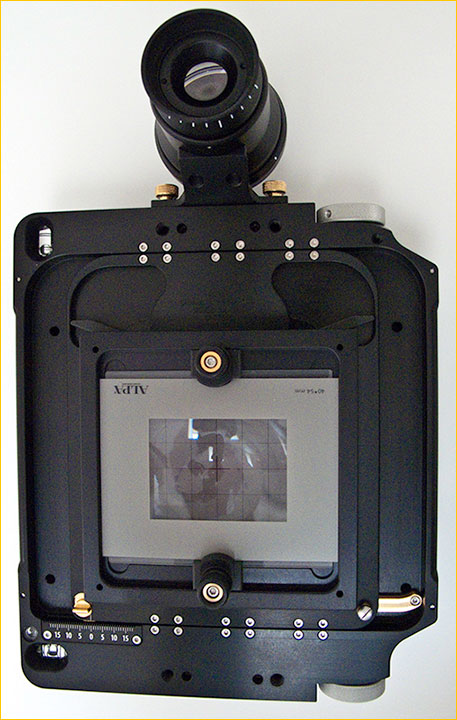
ALPA MAX VIEWED FROM THE BACK
Please note that in the second picture I mounted the groundglass upside down. I did this on purpose to show that the groundglass can be mounted in any vertical or horizontal position (in all ALPA cameras). Ditto for the digital or film backs.
If you notice the large knurled knobs in the top and bottom, rotating these knobs provides extremely fine rise and fall. So fine in fact, that for larger movements you can unlock the gold lock (lower left in the front) picture, make a drastic move by hand and re-lock. Very nice! A similar lock exists in the back.
The MAX feels like a solid block of exquisitely machined alloy. Everything in the camera is there for a purpose. Nothing is superfluous and nothing is missing.
After using the camera for several weeks at my home base in California, and for one week in adverse conditions at Death Valley, I can say without hesitation that this is yet one more jewel of a camera from the folks at ALPA. It is simply an exquisite machine.
___________________________________________________________________________________
INTANGIBLES
The first time I saw an ALPA camera with rosewood grips, I felt I was looking at a gorgeous art object. I could look at it as a piece of high quality art, as well as a fine tool. It definitely looked and felt completely different from those clunky plastic auto everything machines.
Each and every time I use an ALPA I get this amazing pleasure of working with something that has been designed and produced with no compromises and with incredible attention to detail. And yes, some of the materials used can be quite seductive and stunningly beautiful, like the rosewood grips.
Why am I saying this? Because precision breeds precision, and perfection demands perfection. I truly believe that using an ALPA beckons for absolute precision and perfection on the part of the photographer, and this in turn leads to better images. I know that when I shoot with an ALPA, my photography gets better.
I observed a similar situation recently. I was watching a documentary on PBS on how a Steinway Concert Grand piano is built. One of their top craftsmen is in charge of the soundboard, probably the most critical piece. When interviewed, the first thing he showed the interviewer were the precious tools he brought from Europe and has been using everyday for decades. He implied that using these superb tools (as opposed to run of the mill tools from the hardware store), made a huge difference to him and allowed him to make better pianos. He also asserted that musicians are the same way: A great musician will play better on a Steinway.
My take on this is that a good photographer will also benefit from using extremely well made cameras. There is something special about the give and take between an artist and a tool that is so well designed and built, that the tool itself becomes an integral part of the final work of art.
___________________________________________________________________________________
TANGIBLES
Compared to a Medium Format SLR, there are many tangible reasons why one can expect to obtain better image quality with a technical camera. This is particularly true with an ALPA. Some of the reasons are:
1. The lenses are better. This is in large part because there is no mirror. The absence of a mirror gives the designer complete freedom to design the lens as close to the sensor as needed for optimum performance, without regard to specific mirror chamber clearances. Also, there are no moving glass elements, which simplifies the design and allows for much tighter tolerances.
2. There is no mirror vibration.
3. Even with the mirror locked up, there is quite a bit of vibration from focal plane shutters. More than enough to produce blur in the image.
4. Focusing on a groundglass, with a magnifier, is more accurate than any reflex or autofocus system.
5. The precision and tolerances in the ALPA cameras are much tighter than any SLR.
6. And last, but not least, the fact that you can shim the back adapter for optimum positioning of the back.
Let me elaborate on this last point.
Every technical or view camera requires an adapter for the digital back. This allows the backs from all manufacturers to fit into the technical or the view camera. The adapter usually consists of a plate that conforms to the digital back mount on one side and to the camera mount on the other.
However, ALPA has taken a different approach. The company discovered that even though the tolerances on digital backs are quite tight, obviously nothing is perfect, so there are slight variations in the exact positioning of the sensor. The variations from one back to another are usually quite small, but when one is dealing with backs that have around 40-60 Megapixels, these variations are quite visible in the final images. What I am saying, is that in essence, most images will be slightly out of focus, because the sensor is not in the exact perfect position.
We are talking about very small variations, of the order of a few hundredths of a millimeter, but unfortunately they are quite visible in the final image.
So, ALPA, in their quest for perfection, developed a clever idea. The digital back adapter plate consists of two separate plates instead of just one. These two plates are screwed together very tightly, with a set of shims between the plates. Each back adapter is delivered with a full set of shims that allows the user (or the dealer, or ALPA itself) to move the back closer or farther away from the lens in increments of 1/100th of a millimeter.
By the way, Sinar has used peel off foil staples to shim their backs in the past, but the method is not as good as the one ALPA uses.
The procedure for shimming an ALPA back is in principle quite simple. You take a short focal length lens that focuses on a flat plane (focal length lenses around 60-72 mm are ideal for this) and set it at infinity. You take a series of pictures shimming back and forth of objects that are really far away and have clearly discernible detail. I find towers with power cables to be excellent for this. You look at the images on a large computer screen at 100%. After some trial and error, you will hone in on the set of shims that deliver perfect focus. Even if the sensor is somewhat askew, you can cut a corner off of a shim and correct for that also.
It takes 1-2 hours of work to get this done, and frankly, the results are more than worth it (this could obviously be done with a laser interferometer, but the machine is quite expensive and not easily available).
The following link shows the difference between a back set to the exact manufacturer’s specifications, versus a shimmed back. There are two sets of images, wide open and at F/8. The difference is quite remarkable.
http://www.alpa.ch/downloads/ALPA_Adjustment_Test.zip
After purchasing an ALPA and shimming my back, I felt that I had experienced the full performance of my PhaseOne P65+ back for the first time. I could easily resolve the power cables in towers that were 6-7 miles away!
By the way, while we are praising great equipment, I believe that the PhaseOne P 65+ back is overall the best image capture device in existence. As such, it will show the slightest issues or problems; but by the same token, when used with flawless technique and equipment, it will deliver stunning image quality.
___________________________________________________________________________________
DEATH VALLEY
One of the students at the PODAS workshop works with an ALPA TC. This meant that we had a chance to use a TC, an SWA and a MAX.
The comments from the students were universally positive about this experience. As you would expect, there was a lot said about the beauty and the precision of all three cameras, but there was also a lot said about getting back to basics. About a more pure approach to the medium, without mirrors, prisms, motor drives, auto everything electronics and so on. Just the lens, a simple camera, the groundglass, a back and the photographer to make it all happen.
We put all three cameras to the test in a variety of situations, sand dunes, humid areas, cold early mornings, hot days, ghost towns and so on. They always performed flawlessly.

___________________________________________________________________________________
WORKING WITH THE ALPA TC AND THE ALPA MAX
In terms of lenses, I was quite impressed with the new Rodenstock Digarons and the 48mm APO Helvetar. They are all superb lenses. It could easily take another article just to talk about them.
We are very lucky to be living in a time where there seems to be quite a renaissance of superb lens making for digital medium format in Europe.
One lens that did a special job for me on this trip is the new Rodenstock 23 mm Digaron HR. I believe this is the widest rectilinear lens ever made for Medium Format. The perspective it gave me was new, unique and exciting. The sharpness and lack of distortion are quite impressive. The image below speaks for itself.
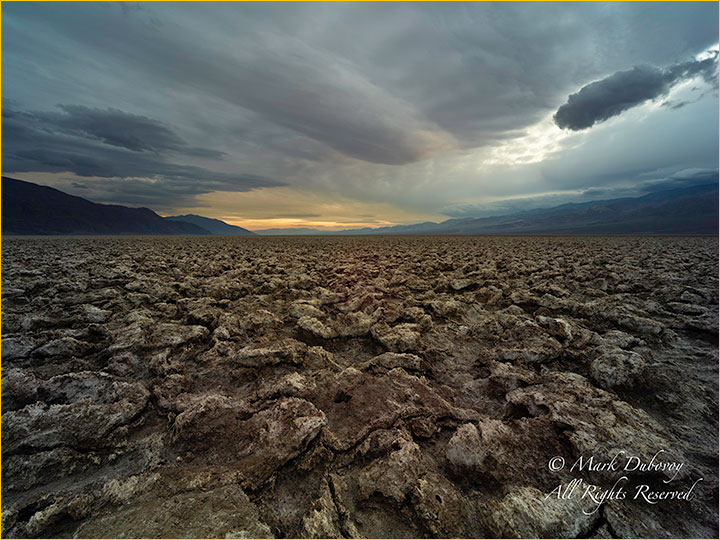
ALPA MAX WITH 23 mm DIGARON HR AT F/11
___________________________________________________________________________________
CONCLUSION
I believe this may be the most enthusiastic review I have ever written about any company and its products. It is a testament to ALPA’s perseverance and uncompromising standards of design and quality that they can make their customers (including myself) feel like this.
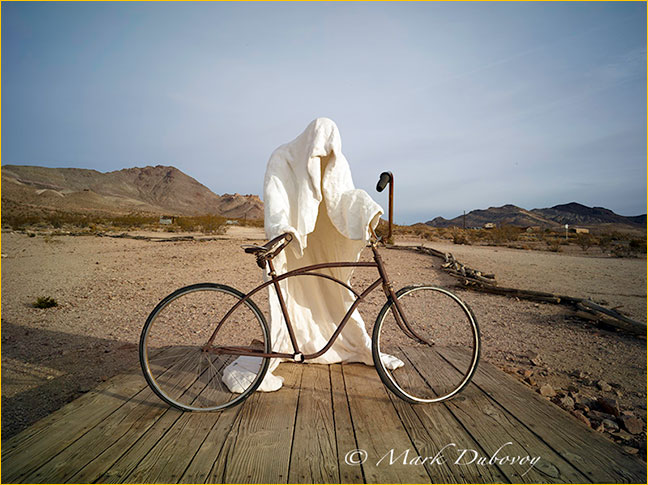
GHOST TOWN
ALPA 12 SWA WITH 35 MM SCHNEIDER APO DIGITAR XL AT F/11
So, are ALPA’s products perfect? Of course not, nothing is, but they are indeed as close to perfection as it gets. Frankly, the only change I wish for in my 12 SWA is a slightly longer PC cable coming out of the grips for easier use with my 180 mm lens. Otherwise, I find no flaw with this camera, and I am extremely picky! As luck would have it, I just found out this morning that a longer cable is now available as a special order item, but I would have to replace my grips.
It is with a feeling of sadness that I am beginning to pack the hardware that ALPA sent me for the field test, as I need to return it all back to the factory.
The MAX camera, accessories and lenses are glorious examples of the best there is in design and manufacturing, and part of me wishes I could own them all and have the time to put them to good use.
November, 2009
___________________________________________________________________________________
Dr. Dubovoy is highly regarded as a technical expert in many aspects of printing technology and photography. As such, he is a regular writer of technical articles for PHOTO Techniques magazine and a lecturer at various workshops.
His photographs are included in a number of private collections, as well as the permanent collections of the Museum of Contemporary Art in Mexico City, the San Francisco Museum of Modern Art, the Monterey Art Museum, the Berkeley Art Museum and the Museum of Modern Art in Nanao Japan.
You May Also Enjoy...
The Photographer at Auteur
A Meditation Around Alan Trachtenberg's bookReading American Photographsand John Brownlow'sHuman Trafficproject. ByMike JohnstonIllustrated with photographs byJohn Brownlow This is an important essay not only because
